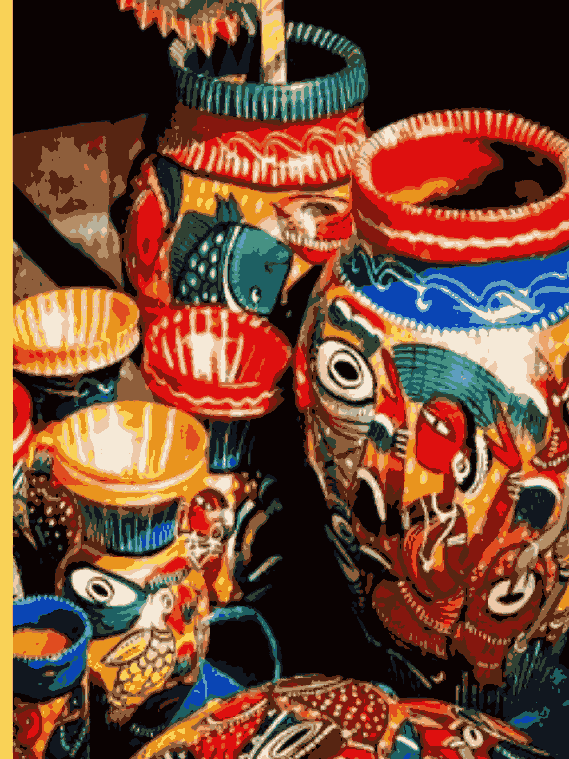Currently Empty: ₹0.00

The Indian state West Bengal is famous for its impeccable art & crafts all over the world. The skills, techniques, and materials used to make handicrafts are extremely unique, durable, beautiful, and fashionable, which creates a great impression globally. Handicraft products can be bamboo to brass handicrafts, dokra metal craft, and wooden hand-crafted items. Bengal’s expert local artists or artisans are skilled in making more different and unique handcrafted items that you have not seen before. Like Terracotta, paintings, pottery, embroidery, tapestry, handlooms, fine muslin, and silk artistry are a few of the examples of handicrafts that originated in the heart of West Bengal. These handicrafts processed in large amounts are known as cottage industries of West Bengal, India. The rural economy depends on these handicrafts and the local artisans.
West Bengal has a cultural and rich heritage. Due to the governance of different rulers in the past, arts and crafts in West Bengal underwent many changes giving an artistic diversity today in the forms of traditional handicrafts, terracotta, painting and carving, dance, music including natural beauty and glorious past of the state has the stronghold of art and architecture which has made the state so unique.


When was Bengal art formed?
The year 1896 was important in the Indian history of visual arts. E. B. Havell and Abanindranath Tagore saw a need to Indianise art education in the country. This began in the Government Art School, Calcutta, and now, Government College of Art and Craft, Kolkata.
Arts of Bengal :
Dokra Metal Craft is one of the most popular forms of art in Bengal. This rare art is the practice of creating statues, jewellery, idols and other pieces with the help of wax, clay and molten metal.
The Chhau mask is a cultural traditional heritage of Purulia in the Indian state of West Bengal. Odisha also has this famous chhau mask but the main difference between West Bengal and Odisha’s mask is the use of the mask. In Odisha they use chhau masks with facial expression, body movement and gestures. In West Bengal the use of Chhau masks in dance is the main thing.
Terracotta Art is a significant example of fine arts in Bengal from the earlier times such as terracotta art in Hindu temples. The roofing and wall style of Bengali Hindu temples, all those architecture is unique and all are related to the roofed traditional building style of rural Bengal. Terracotta has been the symbol of man’s first attempt of craftsmanship. Just as the potter’s wheel was the first machine invented to use the power of motion for a productive purpose.
Patachitra painting is a true cultural and heritage of West Bengal. A cloth-based scroll painting. Patachitra art form is known for its incredible details as well as mythological narratives and folktales inscribed in it. Pattachitra is one of the ancient artworks of India.
Clay Art is one of the best art forms to introduce. West Bengal has a heritage of clay dolls. Dolls have been crafted by Women Potters from the Potter community. Each of the dolls are different in their own way. Every place is famous for different kinds of dolls.
Wooden art is a very old culture of West Bengal. Old ancient wooden statues are found in our museums. The art of making wooden dolls has been an age old practice in West Bengal and Natungram is one of them.
Bamboo Craft is a very old and primeval tradition in West Bengal. Different shapes and patterns of baskets are made using local traditions and techniques with bamboo. In West Bengal bamboo baskets, tray-like, are traditional. There are different types of baskets, hand-held fan, sieves etc. These are also made and painted with good symbols and are used in marriage and other ceremonies.
Handicrafts in India
Handicrafts play a very important role in representing the traditions and culture of any country or region.
The Handicrafts Sector in India plays an important & significant role in the country’s economy. It’s providing employment to a vast segment of craft persons in semi urban & rural areas and generates substantial foreign exchange for the country while preserving its cultural heritage.
With this wide range of craft skills and the number of artisans in the country, India has the potential to make this sector a multi-billion-dollar industry. Handicraft exports from India reached Rs. 25,706.3 crore (US$ 3.5 billion) in 2019–20.
How do handicrafts help economy?
Handicrafts are very important in terms of economic development. They provide ample employment opportunities even with low capital investments and become a prominent medium for foreign income. Before industrial development, this art and industry were a potential economic advantage for the country.
How do you promote handicraft
Assistance provided by the Government for branding/International publicity, marketing study, participation in Exhibitions & Fairs, Buyer Seller Meet in abroad & India etc. through Marketing and other Schemes. Thematic display and live demonstration of crafts by Master Craft’s persons in exhibitions abroad.
